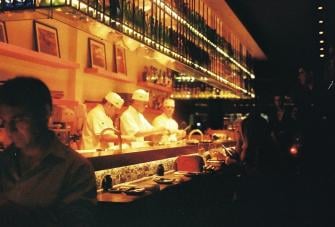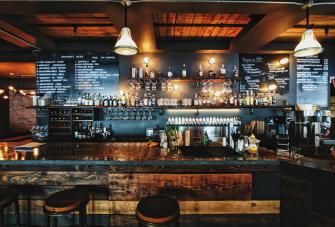The Most Important Server Responsibilities
Whether you're on the hunt for the perfect server to join your team or looking to step into the role yourself, understanding what it takes to excel as a restaurant server is crucial for both employers seeking to build a strong team and individuals aspiring to succeed in the role.
In this blog, we'll cover:
- What it means to be a restaurant server working in a restaurant
- Breaking down the day-to-day server responsibilities and tasks
- Crafting a restaurant server job description that captures the essence of the role
- Exploring the art of delivering excellent restaurant customer service
- Tips on serving food, taking orders, and handling payments
Let's get started.
What is a restaurant server?
A server (AKA a waitress or waiter) is a vital member of the restaurant's front-of-house team, responsible for ensuring guests have a memorable dining experience. Their primary role involves taking and fulfilling food and beverage orders throughout the duration of a guest's visit.
While the terms "waiter" and "waitress" were once commonly used to denote gender-specific roles, the industry now embraces the more inclusive term "server." This acknowledges the importance of gender diversity within the restaurant workforce.
Typically, restaurant servers are hourly employees who earn a significant portion of their income through tips. Although they receive a base wage, often set at the state-mandated minimum wage rate for tipped employees, their earnings are supplemented by gratuities from satisfied customers.
Server responsibilities and tasks
As the frontline representatives of the restaurant, servers play a crucial role in ensuring a seamless dining experience for guests. Here are some of the key tasks and important server responsibilities they handle:
- Making the guests feel welcome: Welcome guests warmly, seating them comfortably, and ensuring their needs are attended to throughout their visit.
- Take and input orders: Accurately record guests' orders and input them into the point of sale (POS) system to facilitate efficient kitchen preparation.
- Provide menu recommendations: Offer suggestions and recommendations based on guests' preferences and dietary restrictions to enhance their dining experience.
- Address allergens and ingredients: Knowledgeably list ingredients and common allergens present in menu items to assist guests in making informed choices.
- Promote specials: Inform guests about menu specials, limited-time offers, and promotions to encourage additional sales.
- Run food and drink orders: Serve food and beverages to guests' tables promptly and efficiently, coordinating with kitchen and bar staff as needed.
- Refill drinks: Monitor guests' beverage levels and offer refills or additional drinks as requested.
- Verify age for alcohol service: Check identification to ensure guests meet legal drinking age requirements before serving alcoholic beverages.
- Handle transactions: Process guest payments accurately and efficiently, including cash, credit card, and gift card transactions.
- Manage receipts: Keep track of credit card receipts and cash payments, ensuring proper reconciliation at the end of each shift.
- Promote loyalty programs: Encourage guests to sign up for the restaurant's loyalty or rewards program to foster repeat business.
- Maintain cleanliness: Keep their assigned section clean and tidy, including tables, chairs, and surrounding areas.
- Bus tables: Clear and clean tables promptly after guests depart to prepare for the next seating.
- Reset tables: Reset tables efficiently to accommodate waiting parties and maintain a smooth flow of table service.
- Restock server stations: Ensure server stations are adequately stocked with napkins, cutlery, condiments, and small plates to meet guest needs.
- Manage soda station: Keep the soda station stocked with cups, refill ice, and maintain cleanliness to provide a pleasant self-service experience for guests.
- Perform roll-ups: Prepare utensil roll-ups for table settings, maintaining consistency and presentation standards.
What to include in a server's job description
When crafting a server job description, it's crucial to provide a comprehensive overview of the role to potential candidates. Here's what the job brief typically includes:
- Role description: Clearly define the position of waitress, waiter, or server within the restaurant's team structure.
- Expectations: Outline the standards of performance and behavior expected from the server, including punctuality, professionalism, and adherence to restaurant policies.
- Responsibilities: Detail the specific tasks and duties that the server will be responsible for, such as taking orders, serving food and beverages, and processing payments.
- Shift details: Provide information about the typical work schedule, including any expected shifts or availability requirements.
- Restaurant information: Offer a brief overview of the restaurant, including its concept, atmosphere, and any unique selling points.
- Compensation and benefits: Clearly state the compensation package, including base pay, tips, and any additional benefits such as employee discounts or healthcare benefits.
- Qualifications: Specify any required qualifications or experience, such as previous restaurant experience or knowledge of specific cuisines.
By including these elements in the server job description, both employers and job seekers can gain a better understanding of the role and whether it aligns with their needs and expectations.
What can and should you expect from your restaurant server?
When setting job expectations for a restaurant server, it's essential to consider both the behavioral aspects and the practical tasks involved in the role. Here are some appropriate job expectations for a restaurant server to add to your restaurant server job description:
- Punctuality: Arriving on time for scheduled shifts to ensure smooth operation of service and this is definitely one to add to your job descriptions.
- Team player: Collaborating effectively with colleagues to deliver great customer service as part of a cohesive team.
- Customer-facing experience: Demonstrating previous experience in roles involving direct interaction with customers.
- Passion for hospitality: Showing genuine enthusiasm for providing excellent service, enhancing the dining experience, and sharing knowledge about food and beverages.
- Communication skills: Having the ability to engage with guests in a friendly and welcoming manner, as well as communicate effectively with colleagues and management.
- Multitasking: Managing multiple tasks efficiently and staying organized during busy periods without becoming overwhelmed.
- Ability to handle pressure: Remaining calm and composed under pressure, maintaining professionalism during demanding situations.
- Adaptability: Being flexible and adaptable to changes in the restaurant environment, such as menu updates or unexpected rushes.
- Menu and order memorization: Quickly learning and recalling menu items and accurately taking orders from guests.
- Patience: Demonstrating patience and understanding when dealing with guests, especially during busy or challenging situations.
- Maths skills: Possess basic mathematical abilities to process payments, calculate tips, and handle transactions accurately.
- Physical endurance: Being capable of performing tasks that require manual labor, such as carrying trays or lifting heavy items.
- Availability: Being willing and able to work nights, weekends, and holidays to accommodate the restaurant's operating hours.
- Physical stamina: Having the endurance to stand and walk for extended periods, typically six hours or more during a shift.
- Customer experience: Focusing on delivering an exceptional dining experience by providing excellent customer service and attending to guests' needs promptly and courteously.
- Timely delivery: Ensuring prompt and efficient delivery of food and beverage orders to enhance the overall dining experience for guests.
- Legal drinking age: Compliance with regulations regarding the service of alcoholic beverages, including verifying the legal drinking age of guests and responsibly serving alcohol.
- Positive attitude: Maintaining a positive and upbeat demeanor to create a welcoming atmosphere and contribute to a positive work environment.
- Responsibility: Taking ownership of tasks and duties assigned, demonstrating reliability and accountability in fulfilling job responsibilities.
- Previous experience: Preferred consideration may be given to restaurant servers with prior experience in the restaurant industry or similar customer service roles.
Best practices for crafting the perfect server job description
So, you've got an opening for a server at your restaurant? Excellent! Now, it's time to craft a restaurant server job description that not only attracts top talent but also sets the stage for success. Here's how:
Be specific and detailed
Describe the role of a server in detail, including responsibilities like taking orders, serving food and beverages, and providing excellent customer service. The more specific you are, the better candidates will understand what the job entails.
Highlight your restaurant's unique features
What sets your restaurant apart from the competition? Whether it's your signature dishes, cozy atmosphere, or live entertainment, be sure to highlight these unique features in your job description to attract candidates who are excited to be a part of your team.
Emphasize the importance of customer service
Customer service is at the heart of the restaurant industry, so be sure to emphasize its importance in your job description. Let candidates know that creating a positive dining experience for guests is a top priority.
Include qualifications and skills
Outline the qualifications and skills you're looking for in a server, such as previous restaurant experience, excellent communication skills, and the ability to work well under pressure. This will help you attract candidates who are the best fit for the role.
Provide clear application instructions
Make it easy for candidates to apply by providing clear instructions on how to submit their application. Whether it's through an online form, email, online job boards or in person, be sure to include all the necessary details.
Showcase your company culture
Give candidates a glimpse into your restaurant's culture and values. Whether it's a fun and lively atmosphere or a focus on teamwork and collaboration, let candidates know what they can expect when they join your team.
Use engaging language
Don't be afraid to inject some personality into your job description! Use engaging language that reflects the vibe of your restaurant and makes candidates excited about the opportunity to work with you.
By following these tips, you can create a server job description that not only attracts top talent but also sets the stage for a successful and rewarding career in the restaurant industry.
Take control with a responsive restaurant POS
Host with confidence when you rely on Epos Now’s dedicated restaurant POS. Process multichannel sales (from in-house, takeaway, and delivery) all in one place!
How can a restaurant POS help?
Imagine a bustling restaurant, orders flying in, customers eager for their meals, and restaurant servers darting between tables. In the middle of this chaos, a reliable POS system becomes your best friend. Here's how a restaurant POS can make your life as a server easier:
- Streamlined order management: With a restaurant POS, servers can quickly and accurately input orders directly into the system. No more scribbling down orders on paper or trying to remember complex modifications – everything is neatly organized and easily accessible.
- Improved communication: A restaurant POS acts as a central hub for communication between front-of-house and back-of-house staff. Orders are sent directly to the kitchen display system, reducing the risk of miscommunication or errors and ensuring a smoother workflow.
- Enhanced efficiency: By automating tasks like order processing and payment handling, restaurant POS software can significantly increase efficiency. Servers can spend less time on administrative tasks and more time focusing on providing excellent customer service.
- Better customer experience: With a restaurant POS, servers can quickly access important information like order history, dietary preferences, and special requests. This allows them to personalize the dining experience for each guest and ensure that their needs are met.
- Real-time insights: Restaurant POS systems often come with built-in reporting and analytics features that provide valuable insights into sales trends, inventory levels, and customer behavior. This information can help restaurant owners make informed decisions and optimize their operations.
- Increased accuracy: Manual order entry is prone to errors, leading to mistakes in both orders and payments. With a restaurant POS, orders are entered electronically, reducing the risk of errors and ensuring greater accuracy.
- Processing payments: A restaurant POS streamlines payment processing by securely handling transactions, including cash, credit card, and gift card payments. This simplifies the checkout process for both servers and guests, reducing wait times and minimizing errors.
- Flexibility and scalability: Whether you're running a small bistro or a large chain restaurant, a restaurant POS can be tailored to meet your specific needs. With scalable features and customizable options, you can adapt your POS system as your business grows.
- Loyalty, marketing and more: With a modern POS system, you should have a lot of POS integrations that you can connect to helping you set up loyalty programs, marketing initiatives, delivering food to people's homes and online ordering.
Serving up our final thoughts
So there you have it. Our complete guide to crafting the perfect server job description! Whether you're on the hunt for the perfect server to join your team or looking to step into the role yourself, understanding what it takes to excel as a restaurant server is key.
In this blog, we've covered what it means to be a restaurant server, breaking down the day-to-day server responsibilities and tasks, crafting a restaurant server job description that captures the essence of the role, exploring the art of delivering excellent customer service, and providing tips on serving food, taking orders, and handling payments.
By following these tips and guidelines, you can attract top talent, set clear expectations, and create a positive and rewarding experience for both servers and guests alike. So what are you waiting for? Let's get started on finding the perfect server for your restaurant!
Enjoyed this blog? Explore more resources to enhance your skills in the restaurant industry:
- Looking to boost your tips as a server? Check out our guide on How to Get More Tips When Working as a Server.
- Want to master the art of upselling? Dive into our tips on How to Upsell as a bartender or server.




